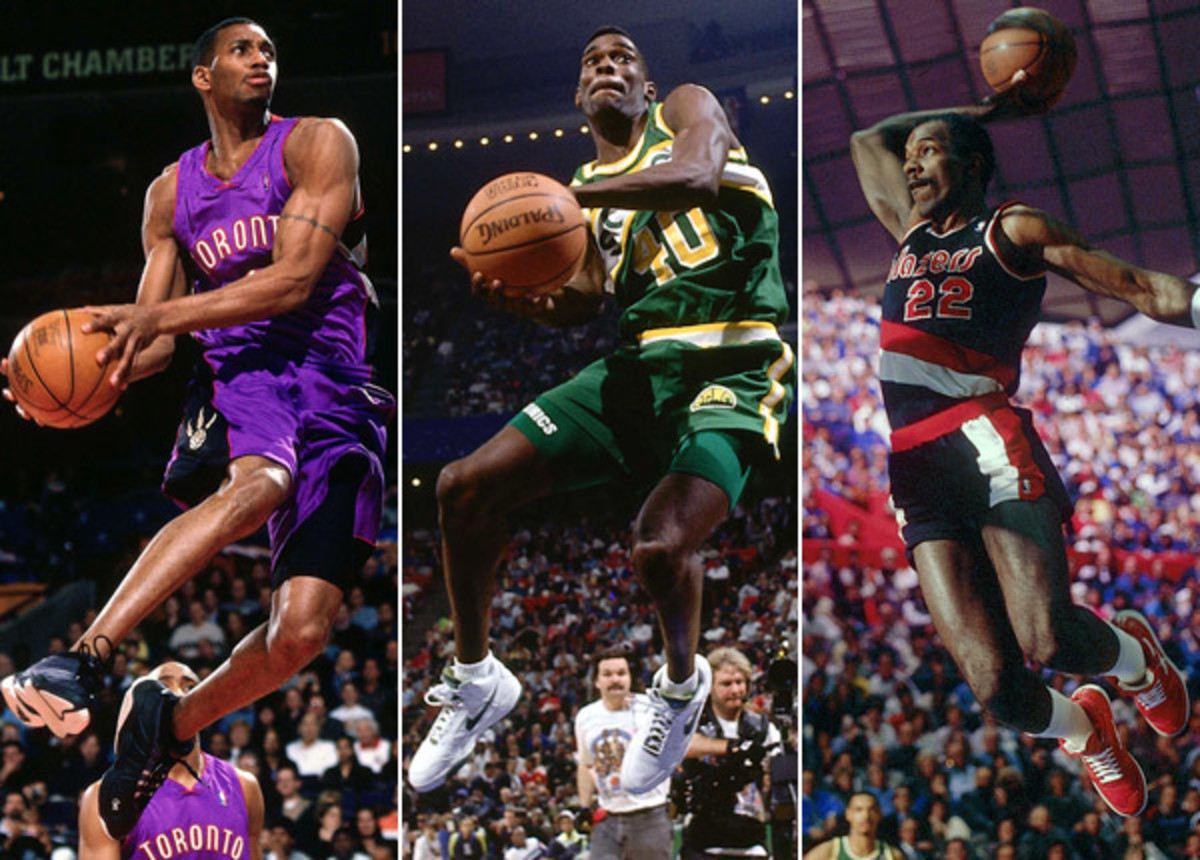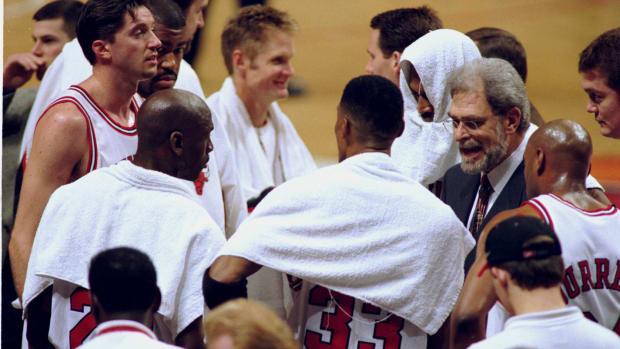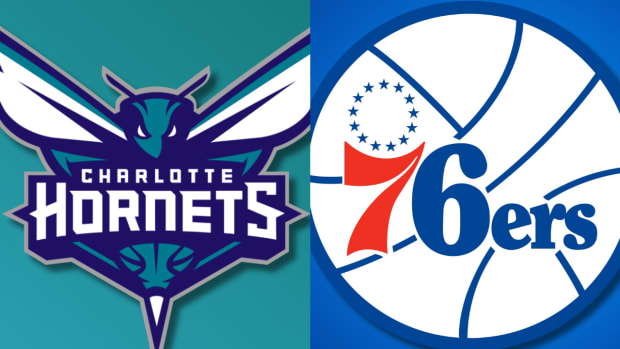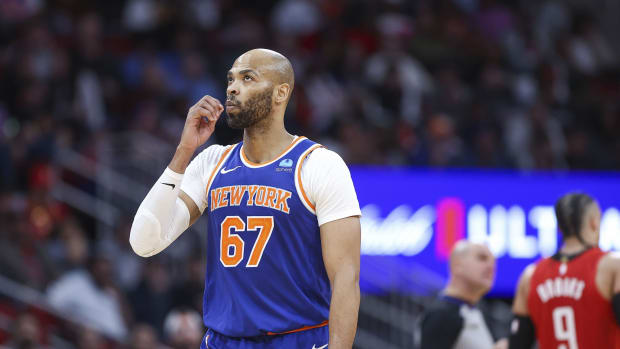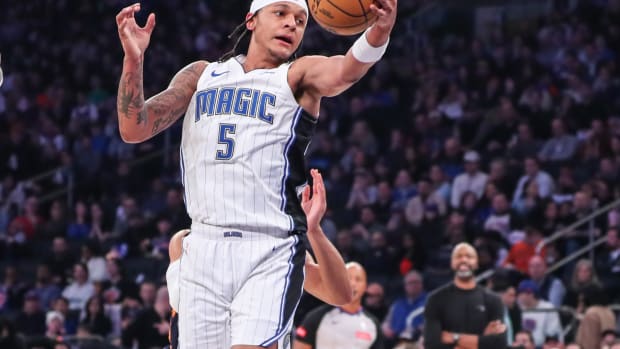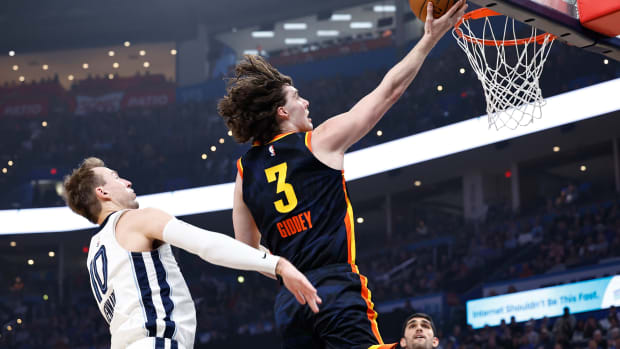The Non-Champions: The five greatest Dunk Contest participants who never won
Some of the greatest dunkers in history never claimed the Slam Dunk Contest title. (Getty Images/SI)
"The Point Forward All-Stars" will have a new theme each week centered on a single shared trait that brings together the team members. This week, we go back in time to look at the greatest participants in Slam Dunk Contest history who never managed to be crowned champion. As we all know, it's better to have dunked and lost than to have never dunked at all.
Previously: The All-Grateful Team | The East's All-Letdown Team | The All-Atrocious Team | The All-Ignored Team | The All-Stocking Stuffer Team | The All-Recalibration Team | The All-Payday Team | The All-Gridiron Team | The All-Sanctioned Team | The All-Dunk Contest Team
This year's Slam Dunk Contest will have a major, fundamental change: Rather than crowning a single champion, like every other Dunk Contest in the history of the world, this year's competition will pit the Eastern Conference against the Western Conference, with the three team members of the winning side all earning the "champion" tag. After the contest, fans will vote on a "Dunker of the Night" title.
There are some thoughtful tweaks that should help the flow of the event, but this "champions" business isn't just a matter of semantics; it's an abomination. "Slam Dunk Contest Champion" is one of the best and most enduring titles that a basketball player can earn, and the conference format undercuts and distorts its value.
Per the contest's rules, the only thing a player needs to do to become one of the "champions" is make a single dunk during the 90-second opening round. After that, he could throw the ball against the rim in the second round, get eliminated and backdoor his way into the "champion" tag as his conference teammates secure the title. Conversely, a player could dominate the opening round, pull off two incredible dunks in the second round, miss out on the "champion" tag because his teammates aren't up to snuff and then watch someone else get "Dunker of the Night" from the fans.
Those are the worst-case scenarios, of course, and it's possible that the new format succeeds in rewarding the best dunking team and that the fans properly vote for the "Dunker of the Night." We'll just have to wait and see whether controversies and snubs can be avoided, and how the post-contest attention and adulation are divvied up between the "Dunker of the Night" or the three champions.
One unintended benefit of the new format: It serves as a reminder that it's possible to be an excellent Slam Dunk Contest participant without actually winning. Champions like Michael Jordan, Dominique Wilkins, Vince Carter, Spud Webb, Dwight Howard, Blake Griffin and Nate Robinson garner most of the discussion when the contest rolls around each year, but there is no shortage of quality players who came up short when it came to the judges.
Here's a look at the five greatest Non-Champions: players who made their mark on the Slam Dunk Contest, even if they never brought home the title.
Tracy McGrady (2000)
Tracy McGrady soars during the 2000 Slam Dunk Contest. (Andrew D. Bernstein/Getty Images)
Together with his cousin and Raptors teammate Vince Carter, a 20-year-old McGrady helped resurrect a contest that hadn't been held since 1997. The 2000 contest placed No. 2 on The Point Forward's list of the 10 best Dunk Contests, trailing only the epic showdown between Jordan and Wilkins in 1988. While Carter, the eventual champion, will always be the headliner, McGrady's performance was worthy of plenty of love, too, and one wonders what would have happened in the decade-plus since if the two hadn't put on such an electrifying show.
The standout quality of McGrady's work in 2000 was his acceleration off the ground: He went from 0-to-60 in the blink of an eye, regularly getting his head near the rim as he performed various lob-style dunks. Past that, McGrady struck the proper balance between smooth execution and powerful finish, making the ferocious look effortless.
His first four dunks all earned approving scores from the judges -- including a "50" for a spinning double-clutch, two-handed dunk off a self alley-oop (3:20 mark in the video above) -- and that body of work would have easily won him any of the Dunk Contests that were held in the 1990s. Who needs a blindfold when you can combine Wilkins-style windmills with Jordanesque levitation?
Like Carter, McGrady went out on top after the 2000 Dunk Contest, never competing again. That night in Oakland was so magical that it would have sent expectations for subsequent performances soaring to impossible heights, making it understandable that McGrady chose to simply drop the mic. That decision leaves McGrady as the best one-and-done Non-Champion in the contest's history.
Video via YouTube user Swove2204
Shawn Kemp (1990, 1991, 1992, 1994)
Shawn Kemp competes at the 1991 Slam Dunk Contest. (Nathaniel S. Butler/Getty Images)
Before the drug problems, weight problems and child-support problems, Kemp was the "Reign Man," a 6-foot-10 monster who seemed a good 10 years ahead of his time, at least, when he competed in four Dunk Contests in the early 1990s. A less restrained, less polished successor to Wilkins, Kemp was a Goliath who consistently did battle with smaller competitors, a fact that many observers believe winds up being a disadvantage.
Kemp made his debut as a 20-year-old rookie at the 1990 Dunk Contest, which was won by Wilkins. His first attempt packed so much punch that it sent him flying to the ground, causing the television broadcasting crew to wonder whether he had hurt himself. By the next season, Kemp had ironed out some of the kinks, putting on a great show in a contest that Dee Brown, the ultimate David to Kemp's Goliath, won with his Reebok pumps and his forearm-across-the-eyes "no-look" dunk.
Kemp's performance was jaw-dropping without the gimmicks. In a contest full of memorable moments, Kemp's mid-air bicycle ride was the most impressive (4:00 mark in the video above), and it holds up more than 20 years later, even though he's stuck with the Non-Champion tag.
The 1991 event would prove to be the highlight of Kemp's Dunk Contest career, as he didn't advance out of the first round in 1992 and finished a distance third in 1994. In retrospect, his biggest weakness wound up being a lack of variety: He just couldn't muster enough ways to set up his sledgehammer finishes that would hold the audience's attention and overshadow the likes of Wilkins, Brown, Kenny Smith, John Starks, Cedric Ceballos, Isaiah Rider and Robert Pack. Credit Kemp, who made six straight All-Star appearances and three consecutive All-NBA teams in the 1990s, for competing again and again as his star blossomed. His complete lack of bashfulness when it comes to the Dunk Contest is sorely missing among the league's biggest stars these days.
Clyde Drexler (1984, 1985, 1987, 1988, 1989)
Clyde Drexler skies in the 1987 Dunk Contest. (Walter Iooss Jr./Sports Illustrated Classic)
There is only one man who tried and failed to win the Dunk Contest more times than Kemp. That distinction belongs to Drexler, a Hall of Fame guard who went 0-for-5 during the 1980s.
Drexler began his Dunk Contest career as a 21-year-old rookie, fresh off a successful college career with the famed "Phi Slamma Jamma" squads at Houston. By the time he called it quits, six years later, he was well into a stretch of seven consecutive All-Star appearances and -- it must be noted -- he had significantly less hair. Drexler was technically sound and consistent but he never quite had a signature moment to put him over the top. He favored precise looks -- double-clutches, cock-backs, reverses and windmills -- that were good enough to help him advance in 1987 and 1988 but not quite good enough to topple the monolithic Jordan. That matchup would prove to be a problem in the 1992 Finals, too, as Jordan's Bulls prevailed over Drexler's Trail Blazers.
The closest Drexler came to winning was 1989, a contest held in his hometown of Houston. That year marked the only time he advanced to the finals during the contest's old three-round format. He got there with a pretty 360, in which he kicked up his legs as he spun (watch here at the 0:45 mark), and a smooth windmill. Once in the finals, Drexler missed his first two dunks and didn't attempt a third, as Kenny "Sky" Walker had run (flown?) away with the victory.
That wasn't the storybook ending Drexler was hoping for, but it wound up securing his title as the most prolific Non-Champion ever. That's not a totally bad thing. By coming up empty on so many occasions and living to tell about it, Clyde The Glide will always serve as the go-to example whenever excuses are made for why someone like LeBron James shouldn't participate.
The 1980s Dunk Contests were loaded to the gills with star power because players like Drexler were willing to put themselves out there, results be damned. Drexler lost to, in order: Larry Nance, Wilkins, Jordan, Jordan and Walker, while also competing against Julius Erving, Tom Champers, Spud Webb and his Blazers teammate Jerome Kersey (who, like Kemp, went 0-for-4 during his Dunk Contest career). Even though the individuals in those contests were Hall of Famers and accomplished dunkers, their collective presence year after year wound up producing a "whole is greater than the sum of the parts" scenario. So much of the mystique surrounding that era, which continues to accumulate more than 20 years later, derives from the murderers'-row nature of the lineups.
Maybe one day, a generation of superstars will take it upon themselves to recreate the high-stakes rivalry between Jordan and Wilkins. If that happens, there will need to be other stars who are willing to swallow their pride and compete for competition's sake, like Drexler.
Video via YouTube user Jobel Porras
JaVale McGee (2011)
JaVale McGee slams two balls in the 2011 Dunk Contest. (Nathaniel S. Butler/Getty Images)
As a goofy big man without All-Star credentials, McGee sticks out like a 7-foot sore thumb from the previous three names on this list. That's OK, because there aren't many lists or groups that McGee, who famously cultivated an alter-ego known as "Pierre," would fit into anyway.
McGee, 26, has competed in only one Dunk Contest: the often-debated 2011 contest won by Griffin. Lacking in star power, name recognition and Kias, McGee nevertheless turned in an unforgettable performance that, start to finish, stands as one of the most creative in contest history.
As Griffin was dunking over a car and Serge Ibaka was removing a doll from the rim with his mouth, McGee opted for the simplest props of all: extra hoops and extra basketballs. The long-armed McGee put his wingspan to full use by dunking two balls into two hoops (2:30 mark in the video above) and dunking three balls through one rim in quick succession (5:30 mark in the video above). To up the degree of difficulty on the double-hoop dunk, he even threw a lob to himself off the backboard to get things started. As commentator Reggie Miller rightly noted on the broadcast (for once), few other players could execute McGee's double feat.
In the final round, McGee made it impossible for anyone to write him off as a "gimmick" dunker. In one of the greatest dunks of all time to watch in slow motion (7:10 mark in the video above), McGee cuffed the ball as he ran in from the left corner, ducking his head to avoid the backboard as he completed a smooth one-handed reverse by scissoring his arm in a classic "rock the cradle" action. A (relatively) pedestrian final dunk -- in which he got his head to rim level and tomahawked the ball through the hoop (8:30 mark in the video above) -- gave way to a fan vote that was bound to favor Griffin, who was also competing in front of the home crowd in Los Angeles.
McGee's thoughtful, well-constructed portfolio could have used one final exclamation point, but it nevertheless stands as an inspiring interpretation of the format. That he managed not to lose his composure when his attention-craving mother made a scene only makes his night that much more remarkable. All told, McGee is a must-have on this list of Non-Champions because he is the counterargument to anyone who claims that "every dunk has been done before." The only true limiting factor is the imagination, and few can match McGee on that front.
Terence Stansbury (1985, 1986, 1987)
The loaded 1985 Slam Dunk Contest field. (Andrew D. Bernstein/Getty Images)
Few NBA players deserve a cult following quite like Stansbury, who went toe-to-toe with Hall of Famers in three consecutive Dunk Contests in the mid-1980s. If you haven't heard Stansbury's name before, don't worry: The 1984 first-round pick started just 31 games with the Pacers and SuperSonics before heading overseas to play in Europe. Does it get any better than a player who competed in the Dunk Contest every season during a career that lasted only three years?
Relative no-namers like Jeremy Evans and James White have become commonplace in the Dunk Contest in recent years, but consider the field that the 23-year-old Stansbury faced as a rookie in 1985: Drexler, Orlando Woolridge, Jordan, Erving, Wilkins, Nance and Darrell Griffith. That's Four Hall of Famers, a three-time All-Star (Nance), the 1981 Rookie of the Year (Griffith), a guy who averaged at least 20 points four times (Woolridge) and Stansbury, who averaged 7.1 points in 17.3 minutes for Indiana that year.
Just look at the promotional photograph above: Stansbury is practically squeezed out of the shot by Erving and Wilkins.
As it turns out, Stansbury was called in as a replacement for Charles Barley that year, according to the Los Angeles Times, and he made the most of his opportunity with his unforgettable "Statue of Liberty" signature dunk.
The dunk was beautiful and much more difficult than he made it look. Getting up a full head of steam from midcourt, Stansbury would rotate 360 degrees in the air before holding the ball out in front of him, like a torch, and dunking it (the first dunk in the video above). He wasn't totally a one-trick pony -- he had flips, scoops, double-clutches -- but none of those efforts stood out from the pack quite like the spinning Statue of Liberty.
Stansbury broke out the Statue of Liberty again in 1986 and 1987, and he was on firm ground as a fan favorite by the dunk's third iteration. Ultimately, he went down as an incredible appetizer for some of the most memorable one-on-one matchups in the contest's history. In all three contests, Stansbury advanced to the second round before giving way to Wilkins/Jordan in 1985, Webb/Wilkins in 1986, and Jordan/Kersey in 1987.
Terence Stansbury competed in three Dunk Contests in three years. (Nathaniel S. Butler & Ron Koch/Getty Images)
A list of Non-Champions would be incomplete without Stansbury, who joins Webb as one of the contest's early every-man underdogs. Although he has reflected on the "politics" involved in the judge's scoring that favored Jordan, Stansbury's presence in the event represents the ideal of the contest's level playing field. Here, if nowhere else, an obscure player destined for a career that would take him to Belgium, France, Israel and Greece, among other places, was able to sit side-by-side with the greatest of all time.
Terence Stansbury (right) enjoys his moment next to Michael Jordan at the 1985 Dunk Contest. (YouTube)
Stansbury never went home a champion but, like the other names on this list, his contributions to the contest haven't been forgotten, even after all these years.






























